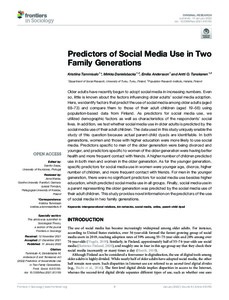Predictors of Social Media Use in Two Family Generations
Danielsbacka Mirkka; Andersson Emilia; Tanskanen Antti O.; Tammisalo Kristiina
Predictors of Social Media Use in Two Family Generations
Danielsbacka Mirkka
Andersson Emilia
Tanskanen Antti O.
Tammisalo Kristiina
FRONTIERS MEDIA SA
Julkaisun pysyvä osoite on:
https://urn.fi/URN:NBN:fi-fe2022081154909
https://urn.fi/URN:NBN:fi-fe2022081154909
Tiivistelmä
Older adults have recently begun to adopt social media in increasing numbers. Even so, little is known about the factors influencing older adults' social media adoption. Here, we identify factors that predict the use of social media among older adults (aged 68-73) and compare them to those of their adult children (aged 19-56) using population-based data from Finland. As predictors for social media use, we utilized demographic factors as well as characteristics of the respondents' social lives. In addition, we test whether social media use in older adults is predicted by the social media use of their adult children. The data used in this study uniquely enable the study of this question because actual parent-child dyads are identifiable. In both generations, women and those with higher education were more likely to use social media. Predictors specific to men of the older generation were being divorced and younger, and predictors specific to women of the older generation were having better health and more frequent contact with friends. A higher number of children predicted use in both men and women in the older generation. As for the younger generation, specific predictors for social media use in women were younger age, divorce, higher number of children, and more frequent contact with friends. For men in the younger generation, there were no significant predictors for social media use besides higher education, which predicted social media use in all groups. Finally, social media use in a parent representing the older generation was predicted by the social media use of their adult children. This study provides novel information on the predictors of the use of social media in two family generations.
Kokoelmat
- Rinnakkaistallenteet [19207]
